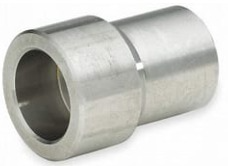Step into the world of stainless steel half couplings. Here, strength and versatility converge. Discover their purpose, types, and the advantages of using stainless steel. Explore their applications across various industries. Understand the key features that make them stand out.
We’ll also compare them with other materials, considering performance and cost. Join us in unraveling the wonders of these essential connectors in the piping world.
What is the purpose of a half coupling?
Socket Weld Half Couplings
A stainless steel half coupling serves as a crucial component in piping systems. It connects two pipes of different diameters. It facilitates a secure and leak-resistant joint. This ensures efficient fluid flow in various industries.
What is stainless steel pipe fitting?
Stainless steel pipe fittings are components designed to connect, control, and redirect the flow of fluids in a piping system. These fittings, such as half couplings, are vital for the system’s integrity and functionality.
Unveiling the Strength
A. Material Composition of Stainless Steel
Stainless steel is a corrosion-resistant alloy. It’s composed of iron, chromium, nickel, and other elements. It forms the robust foundation of half couplings. This unique blend provides durability and resistance to harsh environmental conditions.
B. Structural Integrity of Half Couplings
The structural design of stainless steel half couplings contributes to their strength. These couplings are engineered with precision. They maintain structural integrity under varying pressures. This ensures reliable performance in demanding applications.
Types of Stainless Steel Half Couplings
A. Threaded Half Couplings
Threaded half couplings feature external threads for easy installation. They are suitable for applications where a secure yet detachable connection is required. This makes maintenance and repairs more convenient.
B. Socket Weld Half Couplings
Socket weld half couplings have a recessed area (socket) where the pipe end fits. This design allows for a strong, fillet weld. This design enhances structural stability, making them ideal for high-pressure systems.
C. Welded Half Couplings
Welded half couplings involve a permanent fusion between the coupling and the pipes. This type ensures a leak-proof and robust connection. It is suitable for applications demanding a secure and enduring joint.
Advantages of Stainless Steel
A. Corrosion Resistance
Stainless steel has inherent corrosion resistance. This means half couplings keep their integrity, even in corrosive environments. This makes them suitable for various industries.
B. Durability and Longevity
The durability of stainless steel contributes to the longevity of half couplings. They withstand wear and tear. They provide a reliable, long-lasting solution for piping connections.
C. High Temperature Tolerance
Stainless steel half couplings can withstand high temperatures. They are suitable for applications with hot fluids or extreme conditions.
Applications Across Industries
A. Oil and Gas
In the oil and gas industry, stainless steel half couplings allow reliable connections in pipelines. They ensure efficient fluid transportation.
B. Chemical Processing
Chemical processing plants benefit from stainless steel half couplings. They resist corrosion and maintain the integrity of piping systems handling various chemicals.
C. Water Treatment
In water treatment facilities, these couplings play a vital role. They connect pipes, ensuring the seamless flow of treated water for distribution.
D. Manufacturing
Manufacturing processes often rely on stainless steel half couplings to maintain fluid flow in pipes. This contributes to the overall efficiency of the production line.
Key Features of Stainless Steel Half Couplings
A. Precision Engineering
Stainless steel half couplings are intricately engineered to exact specifications. This ensures precision in their design and functionality.
B. Tight Sealing Mechanism
The tight sealing mechanism of these couplings prevents leaks. It provides a secure and efficient connection in diverse applications.
C. Compatibility with Various Pipes
Stainless steel half couplings are designed to be compatible with a wide range of pipes. They offer versatility in their applications, accommodating different pipe materials and sizes.
Comparisons with Other Materials
A. Stainless Steel vs. Other Coupling Materials
Stainless steel is superior to other coupling materials. It has better corrosion resistance, durability, and overall performance.
B. Performance and Reliability Contrasts
Stainless steel half couplings consistently outperform alternative materials. They excel in terms of performance and reliability. This makes them a preferred choice in demanding applications.
C. Cost Considerations
Stainless steel may have a higher initial cost. However, its long life and low maintenance needs often make it a cost-effective choice in the long run.
Conclusion
Stainless steel half couplings stand as versatile and resilient components in various industries. Their material strength, corrosion resistance, and precise engineering are unique. This combination makes them indispensable. They are necessary for creating secure and durable pipe connections.
Stainless steel half couplings play a pivotal role. They ensure the smooth and efficient flow of fluids. They contribute to the overall success of diverse industrial processes. They’re used in oil and gas, chemical processing, water treatment, and manufacturing.
Post time: Jan-25-2024


